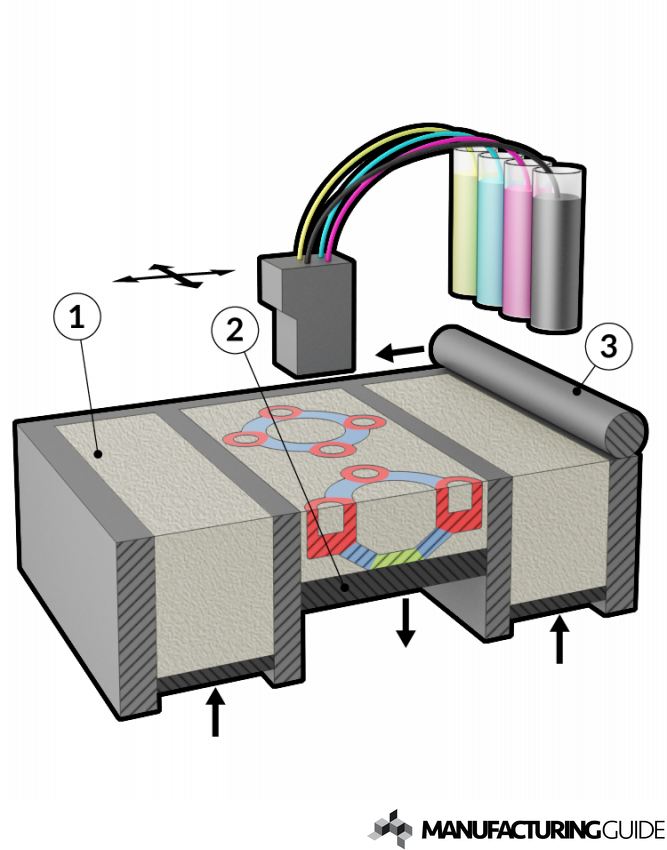
What is CJP 3D Printing ?
Color Jet 3D Printing (CJP), also known as ColorJet Printing, is an additive manufacturing technology renowned for its ability to produce full-color 3D prints.
This process includes a unique post-processing step where CJP parts are infiltrated with a colorbond solution, essentially akin to superglue.
This infusion adds vibrant colors, strength, and cohesion to the printed object.
How does CJP 3D Printing Work?
The 3D model is then converted into a specific file format compatible with the Color Jet 3D printer. This file not only describes the object's geometry but also contains information about the colors and textures to be applied.
During the actual printing process, the Color Jet 3D printer deposits a thin layer of material, usually a fine powder (often gypsum-based), onto a build platform.
A roller ensures even distribution. Following each layer of powder application, an inkjet printhead selectively applies colored binders onto the powder bed.
These binders, akin to a superglue, act as an adhesive, binding the powder particles together to form the 3D object while introducing the desired colors.
The layering process repeats itself, with each layer printed and bound. As each layer is complete, the build platform is lowered, and a fresh layer of powder is applied.
The inkjet printhead continues its precise deposition of colors as dictated by the 3D model file.
Postprocessing
Once the entire object is printed, it remains within the powder bed, with the unbound powder providing support during printing.
Upon completion, the object is carefully removed from the loose powder.
In post-processing, the printed object undergoes specific steps. These include the removal of excess powder, followed by the infiltration of the object with a colorbond solution, similar to a superglue, enhancing both color vibrancy and structural integrity.
Additional finishing touches may also be applied, depending on the printer and materials used.
The outcome is a full-color 3D printed object featuring intricate color patterns and impressive detail. These objects find use in various applications, such as prototyping, marketing materials, architectural models, and more.


Good to know


Fragile till completion
It's important to note that in its "green state," the part is exceedingly fragile, with the strength akin to that of a delicate cookie. This fragility underscores the significance of the structural design, as it must permit careful handling of the part in this state before the infiltration process begins. Thats why it is not recomended to build unsupported walls less than 3 mm. Also "heavy" elements thatare attached to the partvia small or intricate features can break while handeling the part.
No support needed
ColorJet Printing (CJP) 3D printing has a practical advantage in that it doesn't require support structures. This is because CJP utilizes a process where a liquid binding agent is selectively deposited onto a powdered bed to build up layers. This binding process not only shapes the object but also provides enough stability, eliminating the need for additional support structures. This characteristic simplifies the printing process and allows for the creation of intricate and complex designs without the hassle of dealing with extra materials.
Applications
Architectural Marvels:
Architects leverage CJP to transform digital designs into intricate physical models, effectively communicating complex architectural ideas.
The possibility to have the 3D Models fully collored adds a level of realism to the communication with clients.
Educational Excellence:
CJP transcends industries, promoting STEM education by empowering students and researchers to explore hands-on concepts. Its strength in this application lies in its full-color possibilities, providing a visually immersive experience that enhances comprehension and engagement. CJP's capability to produce vibrant, detailed models not only fosters a deeper understanding of STEM concepts but also prepares individuals for the colorful complexities of real-world applications.ts and researchers to explore hands-on concepts.
Medical Breakthroughs:
In healthcare, CJP facilitates the creation of lifelike anatomical models, intricate surgical visualisations, and detailed organ prototypes. Its ability to reproduce full-color, high-resolution images translates into accurate and visually-rich representations, enabling healthcare professionals to visualize and plan procedures with unprecedented precision. This technology plays a pivotal role in advancing medical training, surgical planning, and patient education. With CJP's seamless integration of color and intricate detailing, it opens new frontiers for medical breakthroughs, fostering innovation and improving patient outcomes.
